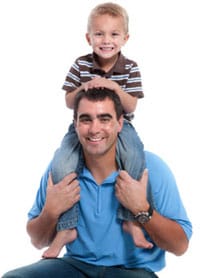Toddlers (2-3 years of age)
Developmental Milestones
Skills such as taking turns, playing make believe, and kicking a ball, are called developmental milestones. Developmental milestones are things most children can do by a certain age. Children reach milestones in how they play, learn, speak, behave, and move (like jumping, running, or balancing).
Because of children’s growing desire to be independent, this stage is often called the “terrible twos.” However, this can be an exciting time for parents and toddlers. Toddlers will experience huge thinking, learning, social, and emotional changes that will help them to explore their new world, and make sense of it. During this stage, toddlers should be able to follow two- or three-step directions, sort objects by shape and color, imitate the actions of adults and playmates, and express a wide range of emotions.
Positive Parenting Tips
Following are some of the things you, as a parent, can do to help your toddler during this time:
- Set up a special time to read books with your toddler.
- Encourage your child to take part in pretend play.
- Play parade or follow the leader with your toddler.
- Help your child to explore things around her by taking her on a walk or wagon ride.
- Encourage your child to tell you his name and age.
- Teach your child simple songs like Itsy Bitsy Spider, or other cultural childhood rhymes.
- Give your child attention and praise when she follows instructions and shows positive behavior and limit attention for defiant behavior like tantrums. Teach your child acceptable ways to show that she’s upset.
Child Safety First
Because your child is moving around more, he will come across more dangers as well. Dangerous situations can happen quickly, so keep a close eye on your child. Here are a few tips to help keep your growing toddler safe:
- Do NOT leave your toddler near or around water (for example, bathtubs, pools, ponds, lakes, whirlpools, or the ocean) without someone watching her. Fence off backyard pools. Drowning is the leading cause of injury and death among this age group.
- Encourage your toddler to sit when eating and to chew his food thoroughly to prevent choking.
- Check toys often for loose or broken parts.
- Encourage your toddler not to put pencils or crayons in her mouth when coloring or drawing.
- Do NOT hold hot drinks while your child is sitting on your lap. Sudden movements can cause a spill and might result in your child’s being burned.
- Make sure that your child sits in the back seat and is buckled up properly in a car seat with a harness.
Healthy Bodies
- Talk with staff at your child care provider to see if they serve healthier foods and drinks, and if they limit television and other screen time.
- Your toddler might change what food she likes from day to day. It’s normal behavior, and it’s best not to make an issue of it. Encourage her to try new foods by offering her small bites to taste.
- Keep television sets out of your child’s bedroom. Set limits for screen time for your child to no more than 1 hour per day of quality programming, at home, school, or afterschool care and develop a media use plan for your family.external icon
- Encourage free play as much as possible. It helps your toddler stay active and strong and helps him develop motor skills.
- Make sure your child gets the recommended amount of sleep each night: For toddlers 1-2 years, 11–14 hours per 24 hours (including naps)
For More Information
CDC’s “Learn the Signs. Act Early.” Campaign
For more details on developmental milestones, warning signs of possible developmental delays, and information on how to help your child’s development, visit the “Learn the Signs. Act Early.” campaign website.
CDC’s Parent Information (Children 0―3 years)
This site has information to help you learn how to give your child a healthy start in life.
CDC’s Essentials for Parenting Toddlers and Preschoolers
Learn ways you can help build a safe, stable, and nurturing relationship with your child.
CDC’s Breastfeeding Information
This site has answers to frequently asked questions about breastfeeding.
CDC’s Information on Infant and Toddler Nutrition
Tips for Parents – Ideas to help children maintain a healthy weight.
CDC’s Protect the Ones You Love
CDC’s Injury Center has information on how you can protect your child from drowning and other common causes of injury.
CDC’s Information on Vaccinations
View the immunization schedule for infants and children and find out if your child’s vaccinations are up to date.
My Plate – Infantsexternal icon
The U.S. Department of Agriculture provides information on health and nutrition for 2 through 5 years of age.
My Plate – Toddlersexternal icon
The U.S. Department of Agriculture provides information on health and nutrition for toddlers
HealthyChildren.orgexternal icon
AAP’s Healthy Children website provides information on feeding, nutrition, and fitness for all developmental stages from infancy to young adulthood.
Just in Time Parentingexternal icon (JITP)
Quality, research-based information to families at the time it can be most useful.
Healthy Kids Healthy Futureexternal icon
You will find information on physical activity for young children and on ways to keep them moving.
National Highway Traffic Safety Administrationexternal icon (NHTSA)
NHTSA has information on safety recalls and safety tips for children riding in motor vehicles, walking, biking, playing outside, waiting at school bus stops, and more.
National Institute of Child Health and Human Development.external icon (NICHD)
Visit NICHD to learn how to reduce the risk of Sudden Infant Death Syndrome (SIDS) and about safe sleep environments.
World Health Organization information on infant nutritionexternal icon
This site has information to promote proper feeding for infants and young children.
CDC’s “Learn the Signs. Act Early.” Campaign
For more details on developmental milestones, warning signs of possible developmental delays, and information on how to help your child’s development, visit the “Learn the Signs. Act Early.” campaign website.
CDC’s Parent Information (Children 4−11 years)
This site has information to help you guide your child in leading a healthier life.
CDC’s Essentials for Parenting Toddlers and Preschoolers
Learn ways you can help build a safe, stable, and nurturing relationship with your child.
CDC’s Healthy Weight Information.
Tips for parents – Ideas to help children maintain a healthy weight.
CDC’s Youth Physical Activity Guidelines
This site has information on how to help children be active and play.
My Plate- Preschoolersexternal icon
The U.S. Department of Agriculture provides information on health and nutrition for preschoolers.
HealthyChildren.orgexternal icon
AAP’s Healthy Children website provides information on feeding, nutrition, and fitness for all developmental stages from infancy to young adulthood.
Just in Time Parentingexternal icon (JITP)
Quality, research-based information to families at the time it can be most useful.
Healthy Kids Healthy Futureexternal icon
You will find information on physical activity for young children and on ways to keep them moving.
National Highway Traffic Safety Administrationexternal icon (NHTSA)
NHTSA has information on safety recalls and safety tips for children riding in motor vehicles, walking, biking, playing outside, waiting at school bus stops, and more.
CDC’s Parent Information (Children 4 — 11 years)
This site has information to help you guide your child in leading a healthier life.
CDC’s Healthy Weight Information.
Tips for parents – Ideas to help children maintain a healthy weight.
CDC’s Youth Physical Activity Basics
This site has information on how to help children be active and play.
CDC’s Kids Quest
Kids Quest is a CDC website designed for students in fourth, fifth, and sixth grades, to get them to think about people with disabilities and some of the issues related to daily activities, health, and accessibility.
CDC’s BAM! Body and Mind
CDC’s BAM! Body and Mind is a website designed for kids 9 through 13 years of age to give them the information they need to make healthy lifestyle choices. The site focuses on topics that kids told us are important to them—such as stress and physical fitness—using kid-friendly lingo, games, quizzes, and other interactive features.
My Plate – Kidsexternal icon.
The U.S. Department of Agriculture provides information on health and nutrition for children over 5 years of age.
HealthyChildren.orgexternal icon
AAP’s Healthy Children website provides information on feeding, nutrition, and fitness for all developmental stages from infancy to young adulthood. Visit this website to learn more about emotional problemsexternal icon, learning disabilitiesexternal icon and other health and development concerns.
Just in Time Parentingexternal icon (JITP)
Quality, research-based information to families at the time it can be most useful.
Let’s Move-Kidsexternal icon
Five simple steps for parents towards creating a healthy environment at home.
National Highway Traffic Safety Administrationexternal icon (NHTSA)
NHTSA has information on safety recalls and safety tips for children riding in motor vehicles, walking, biking, playing outside, waiting at school bus stops, and more.
StopBullying.govexternal icon
StopBullying.gov provides information from various government agencies on how children, parents, educators and others in the community can prevent or stop bullying.
SAMHSA’s KnowBullying appexternal icon
A free app for parents to help prevent bullying, created by the Substance Abuse and Mental Health Agency (SAMHSA).
Teens Healthexternal icon
Visit this site for information on healthy eating and exerciseexternal icon for children and teenagers, safety tips for your child at homeexternal icon when you can’t be there, and other important health and safety topics.
CDC’s Adolescent and School Mental Health
Learn how connection is key to good adolescent mental health.
CDC’s Parent Information (Teens 12— 19)
This site has information to help you learn how to guide your teen to be safe and become a healthy and productive adult.
CDC’s Healthy Weight Information.
Tips for parents – Ideas to help children maintain a healthy weight.
CDC’s Youth Physical Activity Guidelines
This site has information on how to help children be active and play.
CDC’s Pregnancy Prevention for Teens.
Tips and information especially for teens and designed with input from teens.
CDC’s BAM! Body and Mind
CDC’s BAM! Body and Mind is a website designed for kids 9 through 13 years of age, to give them the information they need to make healthy lifestyle choices. The site focuses on topics that kids told us are important to them—such as stress and physical fitness—using kid-friendly lingo, games, quizzes, and other interactive features.
CDC’s Information on Lesbian, Gay, Bisexual, and Transgender Youth Health
Learn about the physical and mental health of lesbian, gay, bisexual, and transgender youth
American Academy of Child & Adolescent Psychiatryexternal icon
The American Academy of Child & Adolescent Psychiatry has many fact sheets for parents on child and adolescent health and development.
My Plate – Teenexternal icon
The U.S. Department of Agriculture provides information on health and nutrition for teens.
HealthyChildren.orgexternal icon
AAP’s Healthy Children website provides information on feeding, nutrition, and fitness for all developmental stages from infancy to young adulthood.
Just in Time Parentingexternal icon (JITP)
Quality, research-based information to families at the time it can be most useful.
National Highway Traffic Safety Administrationexternal icon (NHTSA)
NHTSA has information on safety recalls and safety tips for children riding in motor vehicles, walking, biking, playing outside, waiting at school bus stops, and more.
National Institute of Mental Healthexternal icon
The National Institute of Mental Health has information on mental disorders affecting children and adolescents, including anxiety and depression.
StopBullying.govexternal icon
StopBullying.gov provides information from various government agencies on how children, parents, educators, and others in the community can prevent or stop bullying.
SAMHSA’s KnowBullying appexternal icon
A free app for parents to help prevent bullying, created by the Substance Abuse and Mental Health Agency (SAMHSA).
Substance Abuse and Mental Health Services Administration (SAMHSA)external icon
SAMHSA works to improve the quality and availability of substance abuse prevention, alcohol and drug addiction treatment, and mental health services.
Teens Healthexternal icon
Visit this site for information on healthy eating and exercise for children and teenagers.

